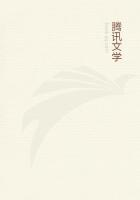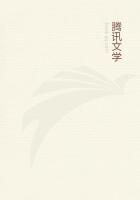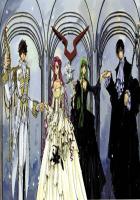Why these curves should be so charming it would be hard to say; they have an exquisite prankishness of variety, the place where the upward or downward scrolls curl off from the main wave is delicately unexpected every time, and - especially in gold embroideries - is sensitively fit for the material, catching and losing the light, while the lengths of waving line are such as the long gold threads take by nature.
A moment ago this art was declared not human.And, in fact, in no other art has the figure suffered such crooked handling.The Japanese have generally evaded even the local beauty of their own race for the sake of perpetual slight deformity.Their beauty is remote from our sympathy and admiration; and it is quite possible that we might miss it in pictorial presentation, and that the Japanese artist may have intended human beauty where we do not recognise it.But if it is not easy to recognise, it is certainly not difficult to guess at.And, accordingly, you are generally aware that the separate beauty of the race, and its separate dignity, even - to be very generous - has been admired by the Japanese artist, and is represented here and there occasionally, in the figure of warrior or mousme.But even with this exception the habit of Japanese figure-drawing is evidently grotesque, derisive, and crooked.It is curious to observe that the search for slight deformity is so constant as to make use, for its purposes, not of action only, but of perspective foreshortening.With us it is to the youngest child only that there would appear to be mirth in the drawing of a man who, stooping violently forward, would seem to have his head "beneath his shoulders." The European child would not see fun in the living man so presented, but - unused to the same effect "in the flat" - he thinks it prodigiously humorous in a drawing.
But so only when he is quite young.The Japanese keeps, apparently, his sense of this kind of humour.It amuses him, but not perhaps altogether as it amuses the child, that the foreshortened figure should, in drawing and to the unpractised eye, seem distorted and dislocated; the simple Oriental appears to find more derision in it than the simple child.The distortion is not without a suggestion of ignominy.And, moreover, the Japanese shows derision, but not precisely scorn.He does not hold himself superior to his hideous models.He makes free with them on equal terms.He is familiar with them.
And if this is the conviction gathered from ordinary drawings, no need to insist upon the ignoble character of those that are intentional caricatures.
Perhaps the time has hardly come for writing anew the praises of symmetry.The world knows too much of the abuse of Greek decoration, and would be glad to forget it, with the intention of learning that art afresh in a future age and of seeing it then anew.
But whatever may be the phases of the arts, there is the abiding principle of symmetry in the body of man, that goes erect, like an upright soul.Its balance is equal.Exterior human symmetry is surely a curious physiological fact where there is no symmetry interiorly.For the centres of life and movement within the body are placed with Oriental inequality.Man is Greek without and Japanese within.But the absolute symmetry of the skeleton and of the beauty and life that cover it is accurately a principle.It controls, but not tyrannously, all the life of human action.
Attitude and motion disturb perpetually, with infinite incidents -inequalities of work, war, and pastime, inequalities of sleep - the symmetry of man.Only in death and "at attention" is that symmetry complete in attitude.Nevertheless, it rules the dance and the battle, and its rhythm is not to be destroyed.All the more because this hand holds the goad and that the harrow, this the shield and that the sword, because this hand rocks the cradle and that caresses the unequal heads of children, is this rhythm the law; and grace and strength are inflections thereof.All human movement is a variation upon symmetry, and without symmetry it would not be variation; it would be lawless, fortuitous, and as dull and broadcast as lawless art.The order of inflection that is not infraction has been explained in a most authoritative sentence of criticism of literature, a sentence that should save the world the trouble of some of its futile, violent, and weak experiments: "Law, the rectitude of humanity," says Mr Coventry Patmore, "should be the poet's only subject, as, from time immemorial, it has been the subject of true art, though many a true artist has done the Muse's will and knew it not.As all the music of verse arises, not from infraction but from inflection of the law of the set metre; so the greatest poets have been those the MODULUS of whose verse has been most variously and delicately inflected, in correspondence with feelings and passions which are the inflections of moral law in their theme.Law puts a strain upon feeling, and feeling responds with a strain upon law.Furthermore, Aristotle says that the quality of poetic language is a continual SLIGHT novelty.In the highest poetry, like that of Milton, these three modes of inflection, metrical, linguistical, and moral, all chime together in praise of the truer order of life."And like that order is the order of the figure of man, an order most beautiful and most secure when it is put to the proof.That perpetual proof by perpetual inflection is the very condition of life.Symmetry is a profound, if disregarded because perpetually inflected, condition of human life.
The nimble art of Japan is unessential; it may come and go, may settle or be fanned away.It has life and it is not without law; it has an obvious life, and a less obvious law.But with Greece abides the obvious law and the less obvious life: symmetry as apparent as the symmetry of the form of man, and life occult like his unequal heart.And this seems to be the nobler and the more perdurable relation.

